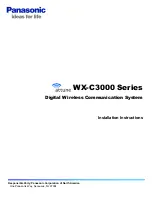
IMPORTANT!! READ ALL INSTRUCTIONS PRIOR TO USE.
FAILURE TO DO SO COULD RESULT IN DAMAGE TO PERSONS
AND PROPERTY.
Thank you for purchasing Hobbico’s
®
Quick Field Charger MkII
™
.
Capable of charging nickel-cadmium (NiCd), nickel-metal hydride
(NiMH), lithium-polymer (LiPo) and lithium-ion (Li-Ion) batteries,
Quick Field Charger MkII is specifically designed for convenience
and flexibility for charging radio batteries at the flight line. It can even
charge park flyer type aircraft batteries! Two independent charge
circuits can each charge transmitter
or
receiver batteries – even
single cells! Adjustable current ranging from 200mA to 2.0A for each
charge circuit is great for custom matching the charger to your
battery’s needs. Three-color LEDs, sound cues and built-in voltmeter
monitoring jacks aid in setting up and monitoring charge progress.
Damage resulting from misuse or modification of this charger
will void your warranty.
Input Voltage:
10-15V DC
Battery Types (each port):
Nickel-Cadmium (NiCd)
Nickel-Metal Hydride (NiMH)
Lithium-Polymer (LiPo)
Lithium-Ion (Li-Ion)
Number Cells (each port):
1-8 NiCd or NiMH, 1-3 LiPo or Li-Ion
Fast Charge Current (each port):
0.2A-2.0A linear(1A max for LiPo)
Fast Charge Termination (each port): Peak Detection (NiCd & NiMH)
CC/CV (LiPo/Li-Ion)
Trickle charge current (each port):
0, 50mA, 85mA & 100mA
(NiCd & NiMH only)
Output connectors:
Banana Jacks
Fuse:
7.5A spade (auto)
Case size:
6.25 x 4.0 x 1.5 in [159 x 102 x 38mm]
Weight:
12.0 oz. [342g]
Safety Timer:
120 minutes - NiCd/NiMH
180 minutes - LiPo/Li-Ion
• Perfect for Tx and Rx batteries. Also good for single cell glow
ignitors, even park flyer batteries!
• EACH port handles 1-8 NiCd or NiMH cells and 1-3 LiPo/Li-Ion cells.
• EACH port offers 0.2A-2.0A of adjustable, linear charge current
(1A max for LiPo/Li-Ion).
• EACH port offers 0, 50mA, 85mA and 100mA trickle charge
currents (NiCd and NiMH only).
• EACH port includes tri-color LEDs and sound cues, for ease of
setup and operation.
• EACH PORT includes built-in jacks for monitoring battery voltage
externally with a voltmeter.
• Peak detection charge method for NiCd and NiMH batteries.
• CC/CV charge method for LiPo/Li-Ion batteries.
• Visual and audible error messages reverse polarity on input or
output and poor output connections.
• Other safety features include time-out charge termination, fused
current overload and reverse polarity protection.
• Same size as regular power panels, for easy mounting in field boxes.
• Rear enclosure included for use as a stand-alone charger.
• Charge only nickel-cadmium, nickel-metal hydride, lithium-polymer
or lithium-ion rechargeable batteries. Do NOT attempt to charge
other types of rechargeable batteries as permanent damage to the
battery and charger could result.
• Do not use automotive type battery chargers to power the charger.
• Do not allow water, moisture or foreign objects into the charger.
• Do not attempt to use batteries with more cells or total voltage than
listed in the specifications.
•
DO NOT LEAVE THE CHARGER UNATTENDED WHILE
CHARGING. DISCONNECT THE BATTERY AND REMOVE
INPUT POWER FROM CHARGER IMMEDIATELY IF THE
CHARGER BECOMES HOT!! ALLOW THE CHARGER OR
BATTERY TO COOL DOWN BEFORE RECONNECTING.
• Do not place the charger or battery on a flammable surface or near
a flammable object while in use. Keep away from carpets, cluttered
workbenches, etc.
• Always turn off the power switch when not in use.
• Do not overcharge batteries as permanent damage could result.
Do not use a charge or discharge current rate which exceeds the
safe level of the battery. Do not attempt to charge or discharge a
battery if it is hot.
• Keep out of reach of children.
While similar in appearance to NiCd batteries and having the same
1.2V rating per cell, NiMH cells contain a different chemical makeup
which requires different care and handling.
•
Do not allow NiMH batteries to overheat at any time.
Heat can
adversely affect the performance of NiMH batteries. If overheating is
observed, disconnect the battery from the charger immediately and
allow to cool! Reduce charge current rate for future charges.
• Do not attempt to use the NiCd or LiPo/Li-Ion charge function with
NiMH batteries.
• Store NiMH packs with some voltage remaining on the cells.
• Use a NiMH battery pack no more than three cycles per day, with
a two to three hour break in-between for cooling. More frequent
use is likely to overheat the pack.
• NiMH cells have a self-discharge range of approximately 20-25%
(compared to 15% for NiCd batteries). Thus, if NiMH batteries have
been inactive for more than a few days it is important to recharge
them immediately prior to use.
Never attempt to care for lithium-polymer (LiPo) or lithium-ion (Li-
Ion) cells in the same way as other battery types!
LiPo/Li-Ion cells
have design and operational characteristics which greatly differ from
NiCd and NiMH batteries and thus have different care and handling
requirements. In addition, do not mistake LiPo or Li-Ion cells for other
lithium-based cell types (such as lithium-metal, etc.), as other lithium
hybrids have different care and handling characteristics as well. All
“lithium” based batteries types are NOT the same.
•
DO NOT ATTEMPT TO USE THE NICD OR NIMH CHARGE
FUNCTIONS WITH LIPO OR LI-ION BATTERIES!
•
THE LIPO/LI-ION CHEMISTRY IS A VERY VOLATILE MIXTURE.
MISUSE CAN QUICKLY RESULT IN CELLS GETTING HOT,
EXPLODING, OR IGNITING WHICH COULD LEAD TO SERIOUS
DAMAGE OR PERSONAL INJURY.
• LiPo/Li-Ion cells have an 8% self discharge rate, meaning they can
hold charge very well. Thus, there is no need to trickle charge
LiPo/Li-Ion cells.
CARE & HANDLING INSTRUCTIONS FOR
LITHIUM-POLYMER AND LITHIUM-ION BATTERIES
CARE & HANDLING INSTRUCTIONS FOR NIMH BATTERIES
IMPORTANT PRECAUTIONS
SPECIAL FEATURES
SPECIFICATIONS
INTRODUCTION






















